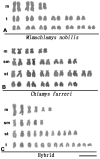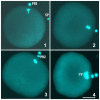Fertilization and cytogenetic examination of interspecific reciprocal hybridization between the scallops, Chlamys farreri and Mimachlamys nobilis
- PMID: 22110617
- PMCID: PMC3215693
- DOI: 10.1371/journal.pone.0027235
Fertilization and cytogenetic examination of interspecific reciprocal hybridization between the scallops, Chlamys farreri and Mimachlamys nobilis
Abstract
Crossbreeding is a powerful tool for improving productivity and profitability in aquaculture. We conducted a pilot study of an artificial cross between two important cultivated scallops in China, Chlamys farreri and Mimachlamys nobilis, to test the feasibility of interspecific hybridization. Reciprocal hybridization experiments were performed using a single-pair mating strategy (M. nobilis ♀ × C. farreri ♂ and C. farreri ♀ × M. nobilis ♂). The fertilization of each pair was tracked using fluorescence staining of the gametes, and the chromosomes of the F1 hybrid larvae were examined via conventional karyotyping and genomic in situ hybridization (GISH). We observed moderate fertilization success in both interspecific crosses, although the overall fertilization was generally less rapid than that of intraspecific crosses. Conventional karyotyping showed that 70.4% of the viable F1 larvae in M. nobilis ♀ × C. farreri ♂ and 55.4% in C. farreri ♀ × M. nobilis ♂ comprised hybrid karyotypes (2n = 35 = 6m+5sm+11st+13t), and the results were further confirmed by GISH. Interestingly, we detected a few F1 from the M. nobilis ♀ × C. farreri ♂ cross that appeared to have developed gynogenetically. In addition, chromosome fragmentations, aneuploids and allopolyploids were observed in some F1 individuals. Our study presents evidence that the artificial cross between M. nobilis and C. farreri is experimentally possible. Further investigations of the potential heterosis of the viable F1 offspring at various developmental stages should be conducted to obtain a comprehensive evaluation of the feasibility of crossbreeding between these two scallop species.
Conflict of interest statement
Figures






Similar articles
-
Genomic in situ hybridization in interspecific hybrids of scallops (Bivalvia, Pectinidae) and localization of the satellite DNA Cf303, and the vertebrate telomeric sequences (TTAGGG)n on chromosomes of scallop Chlamys farreri (Jones & Preston, 1904).Comp Cytogenet. 2018 Mar 13;12(1):83-95. doi: 10.3897/CompCytogen.v12i1.14995. eCollection 2018. Comp Cytogenet. 2018. PMID: 29675138 Free PMC article.
-
An integrated genetic and cytogenetic map for Zhikong scallop, Chlamys farreri, based on microsatellite markers.PLoS One. 2014 Apr 4;9(4):e92567. doi: 10.1371/journal.pone.0092567. eCollection 2014. PLoS One. 2014. PMID: 24705086 Free PMC article.
-
Complete mitochondrial DNA sequence and phylogenetic analysis of Zhikong scallop Chlamys farreri (Bivalvia: Pectinidae).Mol Biol Rep. 2011 Jun;38(5):3067-74. doi: 10.1007/s11033-010-9974-8. Epub 2010 Feb 4. Mol Biol Rep. 2011. PMID: 20131010
-
Tetrodotoxin Detection in Japanese Bivalves: Toxification Status of Scallops.Mar Biotechnol (NY). 2023 Oct;25(5):666-676. doi: 10.1007/s10126-023-10199-3. Epub 2023 Jan 17. Mar Biotechnol (NY). 2023. PMID: 36648572
-
FISH mapping and identification of Zhikong scallop (Chlamys farreri) chromosomes.Mar Biotechnol (NY). 2008 Mar-Apr;10(2):151-7. doi: 10.1007/s10126-007-9045-x. Epub 2007 Oct 23. Mar Biotechnol (NY). 2008. PMID: 17955291
Cited by
-
Genomic in situ hybridization in interspecific hybrids of scallops (Bivalvia, Pectinidae) and localization of the satellite DNA Cf303, and the vertebrate telomeric sequences (TTAGGG)n on chromosomes of scallop Chlamys farreri (Jones & Preston, 1904).Comp Cytogenet. 2018 Mar 13;12(1):83-95. doi: 10.3897/CompCytogen.v12i1.14995. eCollection 2018. Comp Cytogenet. 2018. PMID: 29675138 Free PMC article.
-
Genomic in situ hybridization identifies parental chromosomes in hybrid scallop (Bivalvia, Pectinoida, Pectinidae) between female Chlamysfarreri and male Argopectenirradiansirradians.Comp Cytogenet. 2015 May 20;9(2):189-200. doi: 10.3897/CompCytogen.v9i2.8943. eCollection 2015. Comp Cytogenet. 2015. PMID: 26140161 Free PMC article.
-
Genomic characterization of interspecific hybrids between the scallops Argopecten purpuratus and A. irradians irradians.PLoS One. 2013 Apr 19;8(4):e62432. doi: 10.1371/journal.pone.0062432. Print 2013. PLoS One. 2013. PMID: 23620828 Free PMC article.
References
-
- Beck ML, Bigger CJ. Chromosomal investigation of Ctenopharyngodon idella × Aristichthvs nobilis hybrids. Experientia. 1982;38:319.
-
- Stanley JG. Production of hybrid, androgenetic, and gynogenetic grass carp and carp. Trans Am Fish Soc. 1976;105:10–16.
-
- Yan JP, Sun HL, Fang JG, Zhang X, Chen J, et al. Study on the technology of crossbreeding abalones Haliotis discus discus and Haliotis discus hannai Ino. Mar Fish Res. 1999;20:35–39.
-
- Ye YZ, Wu QJ, Chen RD. Studies on cytology of crosses between grass carp and carp - asynchronization between nucleus and cytoplasm in distant hybridization of fishes. Acta Hydrob Sinica. 1989;13:234–239.
-
- Hedgecock D, Davis JP. Improving pacific oyster brood stock through crossbreeding. J Shellfish Res. 2000;19:614–615.
Publication types
MeSH terms
LinkOut - more resources
Full Text Sources

